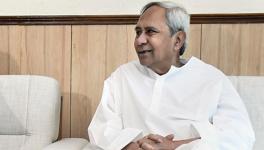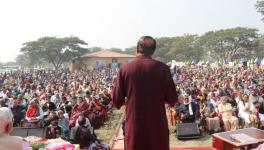Colonial Modernity and the Indian Renaissance
Representational use only.Image Courtesy: Wikimedia Commons
With the onset of colonialism, the ancient framework of coexistence came under stress. Faced with the foreign threat of the British, Indian society was forced to reflect upon its internal constitution. Colonialism provided an external vantage point from which the loosely held diversity of national life had to transcend its status as a structural mode of pragmatic coexistence. To effectively encounter the colonial Other and protect their interests, many of India’s numerous communities began to think about their position in the socio-cultural world, thus generating diverse notions of social good. These differing notions competed not just with one another but with the conception of good attached to the colonial introduction of modernity.
As the elites of various religious entities organised themselves into pressure groups to negotiate with the colonial authority, the self-consciousness of the Indian people came to include a degree of community-based political coherence and national-level exchange of ideas. For example, the growth of new communicative infrastructures and the emergence of census-making sharpened the sense of difference between Hindus and Muslims, giving rise to the statistical imagination of majorities and minorities. Within this numerical battle, the practical behaviour of ineffective intolerance was superseded by the modern capacity to orchestrate well-thought-out communal mobilisations. In such a growing—and discordant—integration and the rise of modern forms of collective action in the political sphere, the local arrangements of static coexistence could no longer function as adequate methods for resolving various conflicts. As Javeed Alam elaborates:
“The happy coexistence of the numerous communities, each living with minimal interactions though with cordial understandings, could no more be taken for granted as in earlier times. This was the source of enormous strains on the inherited capacities of people to handle interpersonal, intra-community, and inter-community relations. This was over and above the new competition generated by the establishment of the colonial economy and administration and the struggle for a share in power in the social arrangement taking shape then. The situation required interlocutors for exchange of opinions and ideas and adjudication of diverging interests and diverse notions of good between these very differently positioned worlds. Successful mediation required either people placed outside the numerous communities or those who could think beyond the limits of these communities, each of which was getting more and more unified as well as assertive. Old-style dialogue, as used to take place between adjacent communities enjoying local autonomy, would no more do between people now more and more distant from one another and demanding things from the world, which was unfamiliar to old type of transactions. All this was to sap the traditionally built-in resources, including those of tolerance and mutual perseverance.”
Thus, India’s interaction with colonial modernity led to novel forms of political churning whose ideological intensities and normative horizons could no longer be contained by the structural pluralism of traditional society. Ancient pluralism was only suitable for the small-scale scenario of pragmatic inter-community interaction—a form of segmented toleration propped up by the lack of a centralised political authority. With the British conquest, India’s fragmented sociological and political landscape had to respond to a common Other embodied in the colonial state. This process of responding to the British state as part of colonial modernity decisively changed the structural organisation of Indian society.
In the pre-colonial society of plural traditions, the state ruled society as a group of rulers separated from the society situated below them, lacking any substantive ideological and institutional bonds with the latter. This allowed Indian society to persist with its compartmentalised dynamic of inter-group toleration. However, with colonialism, the presence of a foreign state not hesitant to introduce deep changes in society led to the politicisation of the latter. Power became the major concern of different groups, with the privileged spokespeople of these groups deploying new idioms to articulate their interests. This produced the conflictual intermeshing of diverse notions of social good. In this condition, what was of prime importance was establishing a secular system that would ensure that the competing and often irreconcilable conceptions of good in public life did not lead to the eruption of conflicts.
The indispensability of secularism, and the need for a principle capable of democratically managing competing notions of good, thus emerged from the internal exigencies of Indian society. But such a need was not satisfied by the peculiar logic of Indian modernity, which produced new styles of culture and politics in a highly uneven manner. The intellectual origins of modernity in India can be found not in an internal dynamic of cultural churning but in the foreign ideas introduced by the British state and its myriad apparatuses. The recipients of these ideas were the newly emerging middle class, which was roughly divided into three sections. One, those who occupied most of the administrative posts in the colonial government. Two, those who enjoyed economic privileges owing to the landed interests created by the Permanent Settlement Act of 1793. And finally, those comprador sections of Indian traders the British valued for their knowledge of internal markets and sources of supply. Given the social and economic proximity of these middle-class trading intermediaries and administrative subordinates to the British state, they were inevitably influenced by Western ideas.
Finding themselves in a novel cultural configuration, the Indian middle class started glorifying the West and imitating the liberal trends of their British superiors—a response that first developed in the presidency towns of Calcutta, Bombay and Madras [now Kolkata, Mumbai and Chennai], and later spread to other parts of the country. Guided by the newfound perspectives of the colonial-modern Other, the westernised middle class of India subjected tradition to critical enquiry. This yielded some positive results. Cruel social practices like sati and infanticide were abolished, irrational religious rituals like hook-swinging and human sacrifice were rejected, and patriarchal regulations over women were loosened to some degree. However, the social base of these reforms was an economically exploitative middle class which mainly wanted to reconcile its traditional position of power with the modern milieu of colonial rulers. They were pursuing the agenda of individualistic compromise that wanted to change native culture without engendering any socio-political radicalism capable of disrupting the economic programme of the British Raj.
Naturally, the primary thrust of 19th-century social reformers was on Reformation of personal faith rather than an all-encompassing vision of Renaissance that could have challenged all kinds of exploitation.
Insensitive to the problem of social exploitation and political subjugation, the approach of the leaders of the Renaissance toward the feudal order and colonial rule was shrouded in confusion and silence. Failure to associate with either the anti-feudal opposition of the oppressed subalterns or the anti-colonial sentiments of the Indian masses restricted the area of operation of the Indian Renaissance. Its middle-class social foundation was content to merely harmonise private religious beliefs with the new conditions of colonial modernity. As such, the conceptual vocabulary of the Indian Renaissance was based on religion and caste, severely neglecting the broader theme of socio-political struggles against exploitation.
Looking inwards within religiocised communities, the Indian Renaissance leaders legitimised or opposed social reforms through an interpretative dependence upon religious texts. “Almost every leader of the renaissance,” KN Panikkar writes, “from Rammohan to Narayana Guru, drew upon Vedanta as the philosophical inspiration of their social vision. It was from the influence of Vedanta that they derived their belief in monotheism and universalism.” Instead of radically transcending tradition through its incorporation into a new secular paradigm, the Indian Renaissance changed tradition through its selective reformulation, conducted in wholly religious terms.
Even when conceptualising monotheism and the unity of godhead, the Indian thinkers of Renaissance put matters in religious language. In the Hindu community, religious Reformation relied upon the Vedas for its articulatory structure, and nearly every Renaissance leader saw the propagation of the Vedas as an important goal: “Rammohan translated the Upanishads into Bengali and English, Debendranath devoted his life to the dissemination of the philosophy of Vedanta from which he earlier received enlightenment, and Keshab Chandra Sen propagated Vedanta through popular publications. Vedanta was the inspiration of Narayana Guru also, even though he belonged to a low caste and his teachings were the ideological influence of a low caste movement.”
A similar influence of religiocised perspectives could be found in the Muslim community. “Be it for a Makti Tangal in Kerala or a Syed Ahmed Khan in North India,” notes Panikkar, “reforms were to follow scriptural prescriptions. However, they tried to interpret scriptures in such a fashion that the demands of a modern society could be accommodated. It was such a perspective which informed Syed Ahmed Khan’s efforts to reconcile Islam with modernity or Makti Tangal’s attitude towards the study of languages.” The constant invocation of religion for either the approval or disapproval of reforms facilitated the growth of particularised identities that stood in antithesis to the universalist social philosophy of the Indian Renaissance. Proclaiming that different religions are just varying embodiments of the same universal truth of humanity’s oneness, Renaissance ideas tried to overcome the various regional and cultural barriers to unite people on a common platform. But these ideas were undermined by the contradictory pull from the solid commitment to scriptural narratives—a narrow approach that failed to transform the religious ideal of universal oneness into the socio-political discourse of equality, justice and fraternity.
As the exclusivist tendency of Indian Renaissance overpowered its universalist message, a new tension emerged between the two basic ideas of Renaissance—rationalism and universalism. Having hitched the project of rationalist critique to the cultural authority of religious re-interpretations, the Indian Renaissance thinkers contributed to the entrenchment of faith as the dominant criterion for considering the validity of any change. The critical application of reason to unjust social practices was set aside in favour of a more subdued strategy of rejigging the textual coordinates of religious teachings to align them with the liberal sensibilities of the Indian middle class.
While this was the general historical outcome of the Indian Renaissance, some cases displayed the alternative trajectories available to the social reformers. This is encapsulated in the journey of the Brahmo movement from Rammohan to Anandamohan Bose, which demonstrates how different class interests led to different cultural strategies on the part of the Renaissance leaders. The early feudal interests of Rammohan and Debendranath circumscribed the extent to which the multiple brutalities of Indian tradition could be resisted. This gave rise to a counter-movement of the young Brahmos, which soon abandoned its former leader Keshab Chandra Sen to press for a more radical agenda, which ultimately resulted in the formation of the Sadharan Brahmo Samaj in 1878—a Brahmo subgroup that advocated for the universal liberation of all people, democratic republicanism and the welfare of labour.
Inspired by Anandamohan, the young Brahmo radicals belonged to middle and lower-class families. Driven by a humanitarian desire to do something for their working-class brethren, they used the legal constitutionalism of Western political theory to protest against the British policy of exploitation of Indian labourers in tea gardens and other places.
Social Scientist, issue 164, 1987, records, “Sibnath Sastri, a leading young Brahmo, published a poem, ‘Sramajibi’ in Bharat Sramajeebi [Vol. 1, 1874, edited by Sasipada Bandopadhya], through which he gave a call to the workers to rise and emancipate themselves from the bondage of exploitation. It may be recalled that Muzaffar Ahmed, one of the founders of the Communist Party of India, recognised Sivnath Sastri as one of the first enlightened persons who welcomed the need to form an organisation for the working class.”
These socio-political expansions of the meaning of Indian Renaissance were weak exceptions to the dominant trend of increasingly religiocised communitarian interests.
The writer is a student based in Aligarh. The views are personal.
Get the latest reports & analysis with people's perspective on Protests, movements & deep analytical videos, discussions of the current affairs in your Telegram app. Subscribe to NewsClick's Telegram channel & get Real-Time updates on stories, as they get published on our website.
























